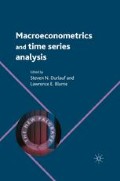Abstract
In the everyday use of the word, a ‘spline’ is a flexible strip of material used by draftsmen in the same manner as French curves to draw a smooth curve between specified points. The mathematical spline function is similar to the draftsman’s spline. It has roots in the aircraft, automobile and shipbuilding industries. Formally, a spline function is a piecewise continuous function with a specified degree of continuity imposed on its derivatives. Usually the pieces are polynomials. The abscissa values, which define the segments, are referred to as ‘knots’, and the set of knots is referred to as the ‘mesh’.
Access this chapter
Tax calculation will be finalised at checkout
Purchases are for personal use only
Preview
Unable to display preview. Download preview PDF.
Bibliography
Craven, P. and Wahba, G. 1979. Smoothing noisy data with spline functions: estimating the correct degree of smoothing by the method of cross-validation. Numerische Mathematik 31, 377–403.
De Boor, C. 2001. A Practical Guide to Splines. New York: Springer-Verlag.
Denison, D., Mallick, B. and Smith, A. 1998. Automatic Bayesian curve fitting. Journal of the Royal Statistical Society: Series B 60, 333–50.
DiMatteo, I., Genovese, C. and Kass, R. 2001. Bayesian curve-fitting with free knot splines. Biometrika 88, 1055–71.
Eubank, R. 1988. Spline Smoothing and Nonparametric Regression. New York: Marcel-Dekker.
Friedman, J. and Silverman, B. 1989. Flexible parsimonious smoothing and additive modeling. Technometrics 31, 3–21.
Green, P. and Silverman, B. 1994. Nonparametric Regression and Generalized Linear Models. London: Chapman and Hall.
Halpern, E. 1973. Bayesian spline regression when the number of knots is unknown. Journal of the Royal Statistical Society: Series B 35, 347–60.
Hansen, M., Kooperberg, C. and Sardy, S. 1998. Triogram models. Journal of the American Statistical Association 93, 101–19.
Kimeldorf, G. and Wahba, G. 1970. A correspondence between Bayesian estimation on stochastic processes and smoothing by splines. Annals of Mathematical Statistics 41, 495–502.
Poirier, D. 1976. The Econometrics of Structural Change with Special Emphasis on Spline Functions. Amsterdam: North-Holland.
Schoenberg, I. 1946. Contributions to the problem of approximation of equidistant data by analytic functions: Parts I and II. Quarterly Journal of Applied Mathematics 4, 45–99; 112–41.
Schumaker, L. 1981. Spline Functions: Basic Theory. New York: Wiley.
Silverman, B. 1985. Some aspects of the spline smoothing approach to nonparametric regression curve fitting (with discussion). Journal of the Royal Statistical Society: Series B 47, 1–52.
Smith, M. and Kohn, R. 1996. Nonparametric regression using Bayesian variable selection. Journal of Econometrics 75, 317–43.
Smith, M., Wong, C. and Kohn, R. 1998. Additive nonparametric regression with autocorrelated errors. Journal of the Royal Statistical Society: Series B 60, 311–31.
Wahba, G. 1978. Improper priors, spline smoothing and the problem of guarding against model errors in regression. Journal of the Royal Statistical Society: Series B 40, 364–72.
Wahba, G. 1983. Bayesian ‘confidence intervals’ for the cross-validated smoothing spline. Journal of the Royal Statistical Society: Series B 45, 133–50.
Wahba, G. 1990. Spline Models for Observational Data. Philadelphia: Society for Industrial and Applied Mathematics.
Whittaker, E. 1923. On a new method of graduation. Proceedings of the Edinburgh Mathematical Society 41, 63–75.
Editor information
Editors and Affiliations
Copyright information
© 2010 Palgrave Macmillan, a division of Macmillan Publishers Limited
About this chapter
Cite this chapter
Poirier, D.J. (2010). Spline functions. In: Durlauf, S.N., Blume, L.E. (eds) Macroeconometrics and Time Series Analysis. The New Palgrave Economics Collection. Palgrave Macmillan, London. https://doi.org/10.1057/9780230280830_28
Download citation
DOI: https://doi.org/10.1057/9780230280830_28
Publisher Name: Palgrave Macmillan, London
Print ISBN: 978-0-230-23885-5
Online ISBN: 978-0-230-28083-0
eBook Packages: Palgrave Economics & Finance CollectionEconomics and Finance (R0)

